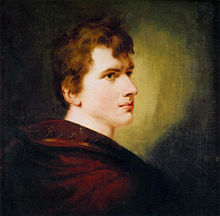Time novel
The Zeitroman is a form of the novel that tries to present the present completely and comprehensibly. The time Roman analyzed the company or the prevailing living conditions and their effects on the individual . Since many authors of contemporary fiction perceive their epoch as a crisis or upheaval , the novels written as analyzes can often be referred to as “critique of time”.
Conceptualization

The term Zeitroman was coined in 1810 by Clemens Brentano for Achim von Arnim's poverty, wealth, guilt and penance of Countess Dolores . He used this to describe an expanded form of the social novel , “which, however, goes beyond the sole representation of societies or one of their classes. It is a form of a novel that depicts the time itself and the epoch through depictions of the people and society of a time. The time novel mostly tries to combine realistic traces and analyzes of society to an objective picture of the time and is therefore a (..) special type of the historical novel . "
Characteristic
His socio-political engagement, which brings him close to trend literature , his cross-sectional simultaneous technique and the juxtaposition of time levels are characteristic.
Examples and development
The time novel is essential for the 19th century. Karl Leberecht Immermann ( Epigonen , 1836; Münchhausen , 1838f.) Is considered to be the founder - even if Joseph von Eichendorff already published a time novel in 1815 with an inkling and present . Further examples in Young Germany are Heinrich Laube ( Young Europe , 1833), Ludwig Tieck ( The young master carpenter , 1836), Karl Gutzkow ( Die Ritter vom Geiste , 1850) and Jeremias Gotthelf ( Zeitgeist and Berner Geist , 1851) and Theodor Mundt . In addition to Gutzkow, Friedrich Spielhagen was one of the most successful representatives of the contemporary novel in the second half of the 19th century , including Berthold Auerbach with several novels, Gustav Freytag's Soll und haben (1855) and Theodor Fontane's Der Stechlin (1898).
Examples from the 20th century are Thomas Mann's Der Zauberberg (1924), Franz Werfels Barbara or Die Pömmigkeit ( 1929) or Robert Musil's Man without Qualities (1930). In general, the genre plays an important role in the literature of the Weimar Republic . Prominent examples from the time after the Second World War are Günter Grass ' Die Blechtrommel (1959), as well as later the works by Heinrich Böll ( Der Engel schwieg , 1949/50, published posthumously in 1992, Die verlorene Ehre der Katharina Blum , 1974), Siegfried Lenz ( German lesson , 1968) or Martin Walser ( marriages in Philippsburg , 1957).
More examples of a time novel
- Joseph von Eichendorff : Premonition and Present (1815)
- Ludwig Tieck : The Young Master Carpenter (1836)
- Ludwig Tieck: Vittoria Accorombona (1840)
- Berthold Auerbach : New Life (1852)
- Karl Gutzkow : The Magician of Rome (1858–61)
- Friedrich Spielhagen : Problematic Natures (1861)
- Berthold Auerbach: The country house on the Rhine (1869)
- Friedrich Spielhagen: Storm surge (1877)
- Karl Gutzkow: The New Serapion Brothers (1877)
- Gottfried Keller : Martin Salander (1886)
- Theodor Fontane : Irrungen, Verrungen (1887)
- Joseph Roth : The Spider Web (1923)
- Thomas Mann : The Magic Mountain (1924)
- Joseph Roth: Hotel Savoy (1924)
- Joseph Roth: The Rebellion (1924)
- Heinrich Mann : A Serious Life (1932)
- Lion Feuchtwanger : Success (1930)
- Irmgard Keun : The Artificial Silk Girl (1932)
- Irmgard Keun: Ferdinand, the man with a kind heart (1950)
- Heinrich Böll : The Angel was silent (1950)
- Wolfgang Koeppen : Pigeons in the Grass (1951)
- Arno Schmidt : The stone heart. Historical novel from 1954 . (1956)
literature
- Peter Hasubek: Karl Gutzkows novels "The Knights of the Spirit" and "The Magician of Rome". Studies on the typology of the German contemporary novel in the 19th century . Dissertation at the University of Hamburg 1964 DNB 482362464 .
- Peter Hasubek: The time novel. A nineteenth-century romance . In: Journal for German Philology , No. 87, 1968; Pp. 218-245.
- Gabriele Henkel: Noise worlds in the German time novel. Epic representation and poetological meaning from romanticism to naturalism. Wiesbaden, Harrassowitz Verlag 1996, ISBN 978-3-447-03827-0 .
- Joachim Worthmann: Problems of the Zeitromans. Studies on the history of the German novel in the 19th century. Winter, Heidelberg 1974, ISBN 3-533-02301-X / ISBN 3-533-02302-8 .
- Dirk Göttsche: Time in the Novel. Literary time reflection and the history of the time novel in the late 18th and 19th centuries. Fink, Munich 2001, ISBN 3-7705-3560-X .
- Peter Mettenleiter, Stephan Knöbl (eds.): Blickfeld Deutsch , Schöningh, Paderborn 2010, ISBN 978-3-14-028235-2 (student volume) / 2011, ISBN 978-3-14-028237-6 (teacher volume).
Individual evidence
- ↑ Hildegard Emmel: History of the German novel. Volume I . Francke Verlag, Bern / Munich 1972.
- ↑ Cf. Osman Durrani, Julian Preece: Travelers through time and space: the German-language historical novel, Volume 51 . Rodopi 2001, p. 210. ISBN 9789042014053 .
- ^ Silke Müller, Susanne Wess: Study book newer German literary studies, 1720-1848: Basic knowledge . Learning and working aids for schools and universities, Königshausen & Neumann 1999 p. 97. ISBN 978-3826017131
- ↑ Peter Hasubek: ... whoever talks the most is the purest person , Volume 152 of Philological Studies and Sources, Erich Schmidt Verlag 1998, p. 19.
- ↑ Hermann Kurzke : Thomas Mann: Epoch, Work, Effect. Work books on the history of literature, CH Beck, Munich 1997, p. 210.
- ↑ Michael Lützeler: "The Europe-Asia Discussion in Thomas Mann's Magic Mountain, in: Understanding Modernity: To the Paradox of a Socio-Aesthetic Pattern of Interpretation , edited by Christine Magerski, Robert Ian Savage, Christiane Weller:, DUV 2007, p. 193. ISBN 978-3835060715 .


